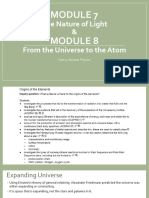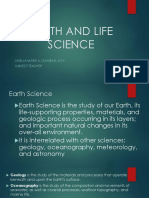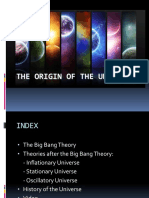Earth Science Reviewer
Earth Science Reviewer
Uploaded by
pmjoygarciaandal09Copyright:
Available Formats
Earth Science Reviewer
Earth Science Reviewer
Uploaded by
pmjoygarciaandal09Original Title
Copyright
Available Formats
Share this document
Did you find this document useful?
Is this content inappropriate?
Copyright:
Available Formats
Earth Science Reviewer
Earth Science Reviewer
Uploaded by
pmjoygarciaandal09Copyright:
Available Formats
Earth Science
Fundamental interactions
The Universe • All forces in the Universe can be attributed to
- Only one exists four fundamental interactions between particles.
- Composed of space and 100 billion galaxies • Physicists believe that all known interactions
- A galaxy is a grouping of millions or billions of were unified at the moment of the Big Bang.
stars kept together by gravity. • Shortly after the Big Bang, this unified
interaction began to separate into gravitational,
The Big Bang Theory strong, weak and electromagnetic interactions.
Discoveries in astronomy and physics suggest • 10^-43 seconds after the Big Bang, gravity
that the Universe had a definite beginning. separated from the unified interaction.
The Big Bang theory is the prevailing theory • 10^-35 seconds after the Big Bang, the strong
that describes the origin and evolution of the interaction separated. This released a vast
Universe. amount of energy, making the Universe expand
It is considered to be our best theory of at an extraordinary rate.
cosmology because it explains most • 10^-12 seconds after the Big Bang, the
experimental observations. electromagnetic and the weak interactions
separated. The four fundamental interactions
What was the Big Bang? were now distinct, as they remain to this day.
- About 13.7 billion years ago, the entire
Universe was compressed into a singularity – a As the Universe cooled, neutrons:
place with zero volume and infinite density. • decayed into protons and electrons, or
- Matter, energy, space and time all began inside • combined with protons to form deuterium.
the singularity.
- At the moment of the Big Bang, the Universe Soon after, deuterium nuclei combined to form helium
started to expand, cool and become less dense. and small amounts of lithium.
- The Universe is still expanding today.
Abundance of hydrogen and helium
What the Big Bang wasn't • The predicted abundance of hydrogen and
• The Big Bang wasn't an explosion that helium depends on the density of the early
happened somewhere in space. Universe.
• The Universe didn't appear somewhere in
space. • Observations indicate that about 24% of the
• The Big Bang created space and time. Universe is
- helium, produced shortly after the Big Bang.
What is an expanding Universe?
• Galaxies move apart because space itself is • The predicted amounts of deuterium, helium
expanding. and lithium agree closely with observed
• They are not moving apart because of some past amounts.
explosion. • This is a major success for the Big Bang Theory
• The universe began with a hot explosion called
the Big Bang. The aftermath of the Big Bang
consisted mostly of radiation, but as things
cooled, the elements hydrogen and helium
formed.
The beginning of the Universe
• The first 10-43 seconds of the Universe is called the
Planck era. Conditions were so extreme that we suspect
quantum behaviour was dominant, including quantum
gravity.
• We don't yet have a theory of quantum gravity, but we
do have theories that explain what happened from this The quark era (10-12 – 10-6 s)
time on. • When the strong interaction separated from the unified
interaction, matter separated into quarks and leptons.
• Quarks 'feel' the strong interaction, but leptons don't. • 8.4 billion years after the Big Bang (4.5 billion years
• The temperature of the Universe was too high for ago), the Solar System began to form from the collapse
quarks to combine. of a giant gas cloud.
The hadron era (10-6 – 1 s) Humans appear on Earth
• As the temperature of the Universe fell, quarks • 13.7 billion years after the Big Bang, human life
combined to form hadrons: protons, neutrons and began on Earth.
their antiparticles.
• As the temperature fell further, most particles "The most incomprehensible thing about the Universe is
annihilated their antiparticles. that it is comprehensible." - Albert Einstein, 1935
• A small excess of particles was left, which accounts
for all hadrons in the Universe today. Science without religion is lame, religion without
• Almost equal quantities of particles and antiparticles science is blind.” - Albert Einstein, 1935
were created.
Other theories about the formation of the Earth:
The lepton era (1 s – 10 s) 1. Steady State Theory
• Once most hadrons had been annihilated, leptons - Hermann Bondi, Thomas Gold and Fred Hoyle
became the dominant form of matter: electrons, in 1948. They said that the universe is
neutrinos and their antiparticles. unchanging in time and uniform in space.
• As the Universe continued to cool, most leptons and - The discovery of cosmic microwave
antileptons annihilated each other. background, CMB, contradicted the basic
• A small excess of leptons was left, which accounts for assumptions of the steady state theory that
all the leptons in the Universe today. everything is constant.
The radiation era (from 10 s) 2. Inflation Theory
• Particle-antiparticle interactions left the Universe full - Proposed by Alan Guth, Andrei Linde, Paul
of radiation (photons). Steinhart and Andy Albrecht.
• Protons and neutrons combined to form hydrogen and - It proposed a period of exponential expansion of
helium nuclei in a process called nucleosynthesis. the universe prior to the more gradual big bang
• Photons were continually absorbed and emitted by explosion.
particles, so the Universe was opaque to radiation. - During this rapid explosion, the energy density
• Towards the end of the radiation era, 300 000 years of the universe was dominated by cosmological
after the Big Bang, hydrogen and helium nuclei started constant-type of vacuum energy.
to capture electrons to form stable atoms. - Later on, the energy decayed to produce the
• The density of the Universe continued to decrease as it matter and radiation which filled up the
expanded. universe.
• The Universe became transparent to light about 370000
years after the Big Bang. 3. String Theory
- The assembly of particle type is replaced by a
The formation of galaxies
fundamental building block called a string with
• A billion years after the Big Bang, stars grouped to
Dimension 1.6 x 10^-35 meters.
form galaxies. Galaxies formed clusters.
- Consistent with quantum gravity.
- It was at this point that there came great hope to
The formation of stars
• Over the next 100 million years or so, the Universe finally unify all known forces and particles into
continued to expand and cool. a single theory of everything.
• Gravitational variations caused matter to clump
together and become hotter and denser. 4. M-Theory
• 100–200 million years after the Big Bang, matter began - This theory considers 11 Space-time dimensions,
to coalesce and form stars. x,y,z time.
• Fusion of light elements in stars released energy and - In the M-Theory, the origin of the universe
formed elements from carbon to iron. occurs as a result of the contact of 2
hyperdimensional branes.
Formation of the Solar System - Stephen Hawking and Leonard Mlodinow argue
that the collision of Membranes leads to a new
universe.
Origin of the Solar System-Theories
waters. And God said “Let there be light” and
The Accretion theory there was light.
- The Sun passes through a dense interstellar
cloud and emerges surrounded by a dusty, Buffon’s Theory
gaseous envelope. - According to Buffon, a comet approaches the
- The problem is that of getting the cloud to form sun very near and smashed with it owing to
the planets. The terrestrial planets can form in a gravitational force. As a result of the impact, a
reasonable time, but the gaseous planets take far significant amount of material was blasted from
too long to form. The theory does not explain the sun and separated from it. After cooling
satellites or Bode's law and is therefore caused condensation, the divided materials
considered the weakest. created planets and asteroids.
Solar Nebular Theory Planet Earth
- The solar system was formed as a result of the
condensation of hydrogen gas and dust referred Earth’s Movements
to as interstellar gas and dust cloud. An • All life on Earth requires solar energy
explosion of stars, a supernova might have • Amount of solar energy is constantly changing because
caused the dust and gas cloud to collapse of the Earth’s rotation, revolution, and tilt.
forming the sun and planets.
- The gas and dust cloud collapsed die to the force Rotation
of gravity. The remaining gas and dust cloud •Earth’s axis is an imaginary rod that runs from the north
form disk-shaped bodies called Solar Nebulae pole to the south pole. As it spins a different part of the
due to rotation. The object formed are called planet faces the sun. It takes 24 hours to complete this
planetisimals. rotation. The sun remains stationary as the Earth turns.
- The massive objects are referred to as
protoplanets. These would later become the Revolution
planets. •As the Earth spins on its axis it also follows an orbit
around the sun.
Alexander Friedmann was a Russian physicist and •The orbit is an ellipse – sometimes Earth is closer
mathematician best-known for his work on the theory of to the sun and sometimes it is farther.
relativity and in particular for introducing the possibility •It takes 365 ¼ days for Earth to complete one
of an expanding universe. revolution. February 29 is added to the calendar every 4
years
Georges Lemaitre was the one who proposed the Big
Bang theory, which is the central pillar of modern Tilt and Latitude
cosmology. •Earth is tilted on its axis 23 ½ degrees. •At any given
time of the year, some locations are
In 1922, a Russian mathematician Alexander Friedmann tilted towards the sun and others are tilted away
and a few years later Georges Lemaître, independently, •This creates winter and summer •Places in a lower
found solutions to Einstein’s gravitational field equations latitude, or close to the equator,
that described a universe in which space itself is receive direct rays from the sun all year long
expanding
The Seasons
Edwin Hubble, for whom the Hubble Space Telescope
is named, was one of the leading astronomers of the Winter and Summer
twentieth century. His discovery in the 1920s •Change in seasons is created by Earth’s tilt.
that countless galaxies exist beyond our own Milky Way •Winter occurs on parts of Earth that are tilted away
galaxy revolutionized our understanding of the universe from the sun get less direct solar energy, cool
and our place within it. temperatures, and less daylight
•Vice versa for summer because of Earth’s tilt, the
What is the Genesis explanation of creation? Northern and Southern hemispheres experience opposite
- In the beginning God created the heaven and the seasons.
earth. And the earth was without form, and void;
and darkness was upon the face of the deep. And Spring and Fall
the Spirit of God moved upon the face of the •As Earth orbits the sun, there are periods
when the poles tilt neither towards or away from the sun.
Forces below Earth’s Surface
• The planet is made up of three layers. (Solid inner core,
liquid mantle, solid crust)
Rainfall and Seasons • Continents are part of the Earth’s crust.
•Some regions have seasons marked by • Plate tectonics suggests that Earth’s surface is divided
rainfall instead of temperatures. into a dozen slow moving plates
•The tropics experience these seasons.
•Winds bring dry or moist air into the Movement of Continents
region and create wet and dry seasons. • Plates move slowly – up to several inches per year
• Over 200 million years we see that continents have
Water on Earth moved a long distance
• Alfred Wegener - continental drift theory
Earth’s Water Supply • Earth’s plates shifted over million of years. Plates are
• Water covers two-thirds of the Earth still moving today. They collide, separate, or slide past
• 97% is salt water – unsafe to drink one another. These movements have shaped our
• Most salt water is found in the oceans landforms
• Some lakes also contain salt water Great Salt Lake, UT
• Freshwater makes up only 3% of the Earth’s water Plates Collide
supply. • Collision of plates create ocean trenches and mountains
• Much of the freshwater is in Earth’s glaciers, and in the • When 2 ocean plates collide, one plate pushes under
ice in the Arctic and Antarctic. The water we use the other. This creates an ocean trench, or deep valley in
everyday is found in lakes, rivers, and under the Earth’s the ocean floor
surface. •The deepest ocean trench is near Japan and the pacific
• Surface water is in streams, rivers, and lakes. •Less plate moves under other plates – Mariana Trench
than 1% of our water supply comes • When an ocean plate and a continental plate collide the
from surface water. ocean plate drop beneath the continental plate. •Causes a
• Streams form from precipitation and join mountain range •The Andes in South America formed
together to form rivers. when the South American plate and the Nazca plate
• Some lakes are formed as rivers fill low lying areas collided.
• Others are formed by glaciers carving • When 2 continental plates collide large mountains are
deep holes in the Earth’s surface •Ex: Great Lakes formed.
• Most of our available freshwater is groundwater. • The Himalayas were formed when the Indian plate
• Groundwater is typically obtained by drilling into the crashed into the Eurasian plate. The Himalayas continue
ground. to grow as the two plates keep crashing into one another.
The Water Cycle Plates Separate
• Water occurs as a solid, a liquid, and a gas. • As plates move apart, gaps between the plates allow
• Water vapor is the invisible gas in the air. magma to rise to the crust.
• Water is always moving on Earth. • Lava emerges from the gap and as it cools it builds a
•The water cycle is this movement mid-ocean ridge, or underwater mountain.
• The Sun’s energy drives the water • Separation of the North American and Eurasian plats
cycle. formed the Mid-Atlantic Ridge.
• Because the cycle is constantly repeating, the supply of •If the mountains rise high enough they form volcanic
water on Earth remains fairly constant. islands - Iceland
Water and People Plates Slide
• Water is crucial for survival • Tectonic plates can slide past one another.
• Many places on Earth face water shortages • This sliding causes earthquakes.
•Flooding can cause property damage and threatens lives • Earthquakes usually take place along faults.
• Water also provides food, power, and recreation • The San Andreas Fault zone in California is a place
where earthquakes are quite common.
The Land • The pacific plate is known as the Ring of Fire because
Landforms it is home to most of the world’s earthquakes and
• Landforms are shapes on the planet’s surface that make Volcanoes.
up the landscapes that surround us.
You might also like
- 8th Grade Criterion BDocument4 pages8th Grade Criterion BNisha KulkarniNo ratings yet
- Lecture 1b Precise LevellingDocument30 pagesLecture 1b Precise LevellingNur Fatin Are Tien58% (12)
- 1 - Origin of The UniverseDocument37 pages1 - Origin of The UniverseMa'am Geneizzel GotuatoNo ratings yet
- Theories On The Origin of The UniverseDocument38 pagesTheories On The Origin of The Universecinammon bunNo ratings yet
- Presentation History of The Universe - PDocument23 pagesPresentation History of The Universe - Praazp9526No ratings yet
- Big Bang TheoryDocument36 pagesBig Bang TheoryMark JamesNo ratings yet
- Origin of The UniverseDocument45 pagesOrigin of The UniverseSheena Jane Tioc100% (1)
- 1st Semester Q1 Earth Science (Notes)Document9 pages1st Semester Q1 Earth Science (Notes)vince.resultay07No ratings yet
- Theories of The Origin of The Universe PDFDocument69 pagesTheories of The Origin of The Universe PDFMariz Santos GeromoNo ratings yet
- UniverseDocument53 pagesUniverseLeo Jr Magbanua100% (1)
- Earth and Life Science FOR PRELIMDocument4 pagesEarth and Life Science FOR PRELIMstudentNo ratings yet
- Unit2 Space ScienceDocument12 pagesUnit2 Space Sciencedhanush02010No ratings yet
- Unit I. Origin and Structure of The Earth Lesson 1: The Universe and The Solar SystemDocument8 pagesUnit I. Origin and Structure of The Earth Lesson 1: The Universe and The Solar SystemMonica RiveraNo ratings yet
- Nucleosynthesis-Stellar EvolutionDocument38 pagesNucleosynthesis-Stellar EvolutionYashashavi Ladha100% (2)
- COSMOLOGY - Study of The Large-Scale UniverseDocument2 pagesCOSMOLOGY - Study of The Large-Scale UniverseMendoza MenoyNo ratings yet
- Origins and Structure of The Universe, The Solar System, and The EarthDocument138 pagesOrigins and Structure of The Universe, The Solar System, and The EarthHenry-ConciseNo ratings yet
- 8.1 Origins of The Elements 1Document67 pages8.1 Origins of The Elements 1hell noNo ratings yet
- The Big Bang Theory and NucleosynthesisDocument13 pagesThe Big Bang Theory and NucleosynthesisGay Delgado100% (1)
- ScienceDocument94 pagesScienceMadelyn ConcepsionNo ratings yet
- The Big Bang TheoryDocument26 pagesThe Big Bang TheoryJboy MnlNo ratings yet
- Physical Science Lesson 1 - Formation of Big BangDocument36 pagesPhysical Science Lesson 1 - Formation of Big Bangrainjarrenperegrino13298No ratings yet
- Earth and Life ScienceDocument48 pagesEarth and Life ScienceAngelica SeñaNo ratings yet
- Eals Lesson1 The UniverseDocument26 pagesEals Lesson1 The UniverseAira Terrado100% (1)
- Origin of The UniverseDocument26 pagesOrigin of The UniverseDoreen Guevarra Ollanas100% (2)
- Physci Week-1Document69 pagesPhysci Week-1Rodelio SorianoNo ratings yet
- Lesson 1 ElsDocument4 pagesLesson 1 Elsshenna fernandoNo ratings yet
- Origin of The Universe Non-Scientific ThoughtDocument1 pageOrigin of The Universe Non-Scientific ThoughtHibari ShinjiNo ratings yet
- Earth Science ReviewerDocument7 pagesEarth Science Reviewerhyper9242No ratings yet
- TOPIC 01 The Origin of The UniverseDocument14 pagesTOPIC 01 The Origin of The UniverseEdward TadlasNo ratings yet
- Universe and The Solar SystemDocument14 pagesUniverse and The Solar SystemBeverly DatuNo ratings yet
- T1-The Origin of The UniverseDocument74 pagesT1-The Origin of The UniverseSofia Nuñez100% (1)
- Earth Science ReviewerDocument19 pagesEarth Science ReviewerShaina Rhaine DigaNo ratings yet
- Big Bang TheoryDocument37 pagesBig Bang TheoryNeov SokoudomNo ratings yet
- lesson-1-ELSDocument44 pageslesson-1-ELSHEIDE FULLEROSNo ratings yet
- Intro To Space ScienceDocument234 pagesIntro To Space ScienceMohsin AbbasNo ratings yet
- Universe FormationDocument3 pagesUniverse FormationEros James JameroNo ratings yet
- Big Bang TheoryDocument6 pagesBig Bang TheorySharreah LimNo ratings yet
- Origin of The UniverseDocument44 pagesOrigin of The UniverseLuis Paz100% (2)
- 2-The Big Bang Theory and NucleosynthesisDocument10 pages2-The Big Bang Theory and NucleosynthesisRant AccountNo ratings yet
- Lesson 1 Big Bang TheoryDocument2 pagesLesson 1 Big Bang TheoryZyreine MenoriasNo ratings yet
- Cosmic Calendar Origin of Universe and Solar SystemDocument76 pagesCosmic Calendar Origin of Universe and Solar SystemXia Fermo100% (1)
- The Origin of ElementsDocument36 pagesThe Origin of ElementsKatherine AliceNo ratings yet
- Bigbang Theory and The Formation of Light ElementsDocument29 pagesBigbang Theory and The Formation of Light ElementsJohn Patrick Carl Hermosura100% (1)
- The Bigbang TheoryDocument30 pagesThe Bigbang TheoryKhyza Cathrene Caliso OringotNo ratings yet
- The Origin of The UniverseDocument15 pagesThe Origin of The UniverseShang KirsteinNo ratings yet
- Nucleosynthesis and Nuclear Reactions 2Document48 pagesNucleosynthesis and Nuclear Reactions 210C- Navarro, Cattlyn, ShaneNo ratings yet
- The Universe and The Solar SystemDocument69 pagesThe Universe and The Solar SystemJustin Mhel VaquilarNo ratings yet
- Bigbang Theory and The Formation of Light ElementsDocument29 pagesBigbang Theory and The Formation of Light ElementsJohn Patrick Carl Hermosura100% (1)
- Universe and The Solar SystemDocument6 pagesUniverse and The Solar SystemCid TristeNo ratings yet
- Lecture OverviewDocument34 pagesLecture OverviewnayemNo ratings yet
- Hand Out First ChapterDocument9 pagesHand Out First ChapterJames Brix Dela CruzNo ratings yet
- Mod1 - Formation of The UniverseDocument2 pagesMod1 - Formation of The Universekathloquellano08No ratings yet
- The Big Bang TheoryDocument18 pagesThe Big Bang TheoryAkash TripathiNo ratings yet
- Reviewer For Long QuizDocument8 pagesReviewer For Long QuizMaureen AkimoriNo ratings yet
- The Universe and The Solar SystemDocument28 pagesThe Universe and The Solar SystemLawrence CezarNo ratings yet
- Earth Science Lesson Solar and Universe Concept Notes 1 8Document8 pagesEarth Science Lesson Solar and Universe Concept Notes 1 8Davis PasuquinNo ratings yet
- Lecturer 1Document38 pagesLecturer 1nayemNo ratings yet
- Lecture-1 - Origin of The Earth PDFDocument31 pagesLecture-1 - Origin of The Earth PDFMd.Minhaz UddinNo ratings yet
- 1.a Big Bang Theory Vs Steady State TheoryDocument20 pages1.a Big Bang Theory Vs Steady State TheoryRicardo R. Antonio Jr.No ratings yet
- Q3 Week 1 A. Final The Big Bang Theory and The Formation of Light ElementsDocument17 pagesQ3 Week 1 A. Final The Big Bang Theory and The Formation of Light ElementsgtyrielNo ratings yet
- Comfort Assessment of High-Rise Timber Buildings Exposed To Wind-Induced VibrationsDocument20 pagesComfort Assessment of High-Rise Timber Buildings Exposed To Wind-Induced VibrationslumoshaozeNo ratings yet
- DPP - 7Document16 pagesDPP - 7vikashvermaiitkgpNo ratings yet
- Mathematics PGDocument51 pagesMathematics PGAnkush PodderNo ratings yet
- WBDesign138 - Load Transient-3Document11 pagesWBDesign138 - Load Transient-3bruno magalhãesNo ratings yet
- Iso 10110-05-2007 (E)Document12 pagesIso 10110-05-2007 (E)HansfuchsNo ratings yet
- Electroquasistatic and Magnetoquasistatic Fields and Boundary ConditionsDocument13 pagesElectroquasistatic and Magnetoquasistatic Fields and Boundary Conditionsatul206No ratings yet
- Questions Stats and TrixDocument39 pagesQuestions Stats and TrixAakriti JainNo ratings yet
- Jordan Ap, MT, Usa: 2017 ASHRAE Handbook - Fundamentals (IP) © 2017 ASHRAE, IncDocument1 pageJordan Ap, MT, Usa: 2017 ASHRAE Handbook - Fundamentals (IP) © 2017 ASHRAE, IncTomNo ratings yet
- St. Anne'S Sr. Sec. School, Jodhpur Half Yearly Exam 2021-2022 Class - Xii (Syllabus and Time-Table) EnglishDocument5 pagesSt. Anne'S Sr. Sec. School, Jodhpur Half Yearly Exam 2021-2022 Class - Xii (Syllabus and Time-Table) EnglishLokender KarwasraNo ratings yet
- Quantifying Origin and Character of Long-Range Correlations in Narrative Texts - Drozdz Et Al. - 2016Document13 pagesQuantifying Origin and Character of Long-Range Correlations in Narrative Texts - Drozdz Et Al. - 2016vmsolartecNo ratings yet
- Muhammad Haziq Bin Abd Rashid - 2020963337 - 8C1 - Case Study 2Document5 pagesMuhammad Haziq Bin Abd Rashid - 2020963337 - 8C1 - Case Study 2haziqNo ratings yet
- General Specification: Welding and MaterialDocument17 pagesGeneral Specification: Welding and MaterialGil-Alain EgnakouNo ratings yet
- Material Data Sheet CW 614n Cuzn39pb3Document1 pageMaterial Data Sheet CW 614n Cuzn39pb3Andrew TanNo ratings yet
- Elden Ring Strength Faith Builds Have My Favorite Weapons!Document1 pageElden Ring Strength Faith Builds Have My Favorite Weapons!ilecto00No ratings yet
- Characterization of Polymers Using Dynamic Mechanical Analysis (DMA)Document8 pagesCharacterization of Polymers Using Dynamic Mechanical Analysis (DMA)Anand NagarajanNo ratings yet
- ME504Document11 pagesME504bariNo ratings yet
- Chapter 5 WorksheetDocument1 pageChapter 5 Worksheetdagim dagimNo ratings yet
- Ielts Usa Practice Ac Reading - AshxDocument9 pagesIelts Usa Practice Ac Reading - Ashxhongngocphamthi203No ratings yet
- 4625 EnuDocument2 pages4625 EnuSalem IereebiNo ratings yet
- Bocci C., Chiantini L. An Introduction To Algebraic Statistics With Tensors 2019Document240 pagesBocci C., Chiantini L. An Introduction To Algebraic Statistics With Tensors 2019Dr AlkerNo ratings yet
- GSS614 - CHAPTER 3 - SoundingDocument44 pagesGSS614 - CHAPTER 3 - SoundingMuhdFikriNo ratings yet
- L01 LCCDE - Direct MethodDocument30 pagesL01 LCCDE - Direct MethodYohan ManaligodNo ratings yet
- TM KNT 001 002 - User ManualDocument55 pagesTM KNT 001 002 - User ManualSergiu PodoreanuNo ratings yet
- 4.normal Distribution Haomin2021Document94 pages4.normal Distribution Haomin2021yanghm669No ratings yet
- Solution DPP Basics JEE Main Crash Course MathonGoDocument9 pagesSolution DPP Basics JEE Main Crash Course MathonGoMohit PatilNo ratings yet
- Chapter 01 - IntroductionDocument25 pagesChapter 01 - IntroductionMuhd MuqhreyNo ratings yet
- Lie Groups Homework SolutionsDocument7 pagesLie Groups Homework Solutionsafetdfyvd100% (1)
- Science 3 DLP Yearly PlanDocument2 pagesScience 3 DLP Yearly PlanSHIAMALA DEVI A/P MUTHUSAMY MoeNo ratings yet

























































































